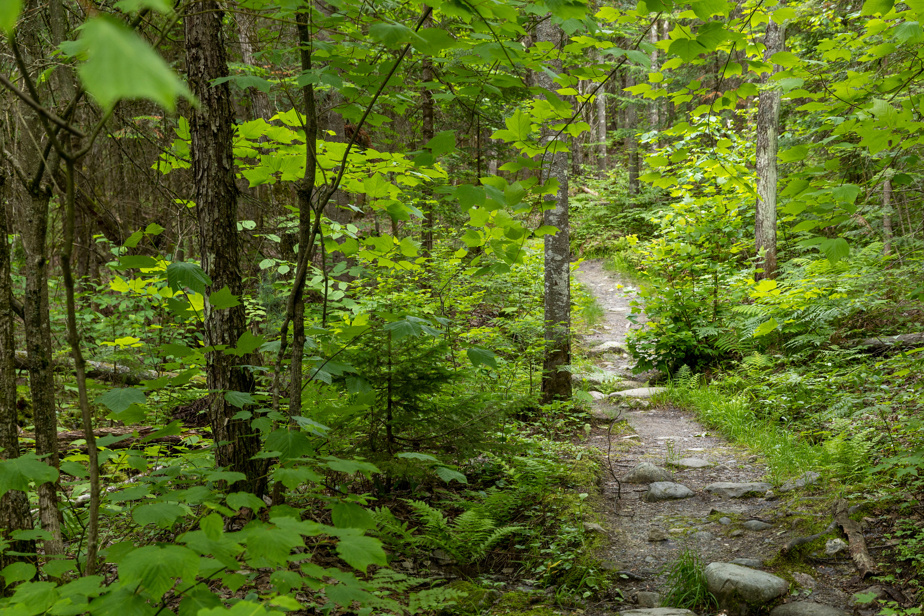Every two weeks, this summer, the author Rafaële Germain offers us a change of pace. It brings us to meet people and places out of time, on the fringes of the mad race.
Except for an open space all around the house, on the edge of the lake, the land my parents had bought in 1988 was completely covered by a mixed forest, aspen, birch, fir and white pine, lots of ferns, a small swamp, rocks, some escarpments. I had to survey every square meter of this small territory during my adolescence, armed with a gourd, a blanket and my recorder – I was a girl equipped. I went beyond the terrain too, in the paths traced by elusive mountain bikes that we never saw and large families of deer that showed up at dusk.
I frolicked there between the oaks and the spruces, giving the elements of the territory pompous names that they had never claimed. The Victor-Hugo stream and Mont Saint-Just thus saw themselves linked to men who had never set eyes on their clear waters and their mossy rocks, strangers who did not like the meager earth they crossed and that they were composing. Those who loved them had left with almost no trace, only a pile of rocks at the very top of the mound, a remnant of forgotten efforts to clear a poor field that the forest had long claimed.
They must have cursed and sweated, these settlers arrived there, no one knows how, following paths of hope and necessity that led beyond the arable lands of the seigniory, to this region of woods and lakes located on the across the North River. Crops were rare, we lived there mainly from cutting wood, but calloused hands got down to clearing land here there, a small plot to meet certain basic needs, we guess lots of potatoes, plots planted with rutabagas, an orchard yielding a few sour apples.
I seem to be extrapolating, but the traces of those forgotten lives are still strewn along these paths, a solitary old apple tree in the middle of a clearing, the nettle-covered foundations of a good stone building , a well that has collapsed in on itself, and, about a hundred meters from an old wooden path that hunters now take each fall, two tombs.
It was the kind of discovery we all dream of making in early adolescence. I was the age of the Goonies at a time when parents let their daughters get lost in the countryside. We had to go to the end of the field, past the abandoned house where we often went to play, despite the clumps of UFFI still clinging to its stone walls. The path then descended through the vinegar groves, to emerge in an old sand pit overgrown with goldenrod and a colony of young birches. A creek ran through it into which someone, at the turn of the 1960s, threw an old turquoise Corvette that still sits there today. We then passed the foundations covered with nettles, the collapsed well and the solitary apple tree, when we got there, everything was vibrating with life in the sun-dappled shade, it was quite clear that people had lived there, had tried to make this corner of the territory their home.
That’s where I found them, in the middle of a three-quarters collapsed circular wall. I was standing in its center, no doubt busy inventing a harsh life as a pioneer, when I felt something hard and flat under my feet.
I pulled up the mosses and the ferns, swept the ground and there they were: two tombstones, toppled long ago – their mossy plinths appeared, just ahead, after further clearing.
In the grip of a highly archaeological fever, I rubbed, blew, and the letters engraved in the stone slowly revealed themselves: Richard and Charlotte, born in Ireland at the end of the 18the century and died there, in the hard and tender lap of the Laurentian forest.
Did they have children? Someone had evidently buried them there, someone who must have known the well and the apple tree and perhaps looked like them. Had there been any little joys in this humble and harsh existence, a tune on the violin, caresses, a swim in the East River at the end of August? I went back to see them often, one summer bringing shoots of daylilies, those unkillable flowers that my father said were escapes from the garden. Today the circular low wall surrounds an enormous tiller of green leaves and orange flowers, they grow there in a dense disorder, between the stelae on which the letters are gradually being erased.
It’s a very, very calm place, where everything flows in the opposite direction of our times. Far, far away from the photos, videos, writings and mountains of possessions that will survive us, Richard and Charlotte rest. They will have left behind them, an unimaginable fact today, an apple tree, two graves, and their names, of course, which now bear a mountain and a stream.

